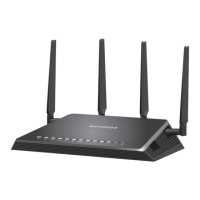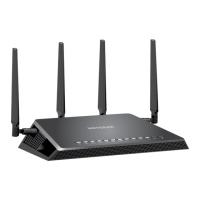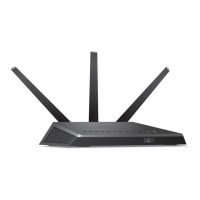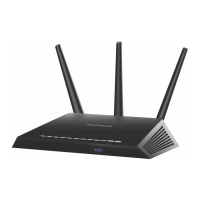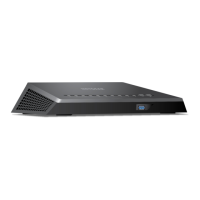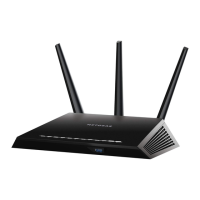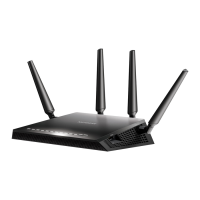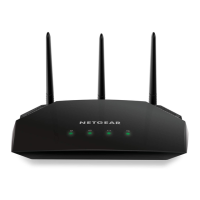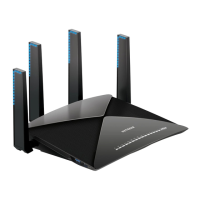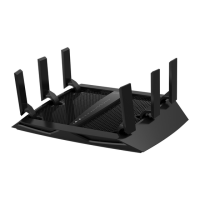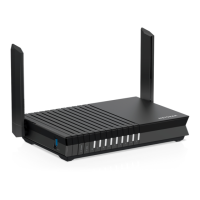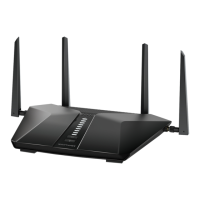Do you have a question about the NETGEAR R7500 and is the answer not in the manual?
Unboxing and identifying router components like antennas, power adapter, and cables.
Details on router top and rear panel features, buttons, LEDs, and ports.
Instructions for attaching antennas and guidelines for optimal router placement.
Step-by-step instructions for cabling the router and connecting it to power and modem.
Methods for connecting devices via wired Ethernet or Wi-Fi, including WPS.
Using a web browser or NETGEAR genie apps to access and configure router settings.
Procedure for changing the router's interface language.
Automated and manual processes for setting up the internet connection.
Setting up various types of IPv6 internet connections like Auto Detect, PPPoE, DHCP.
Adjusting the Maximum Transmission Unit for network performance and compatibility.
Optimizing internet traffic prioritization and bandwidth allocation using Dynamic QoS.
Enabling UPnP for device connectivity and WMM QoS for wireless traffic prioritization.
Configuring parental controls and using keywords to block websites and services.
Managing access lists, exempting trusted computers, and setting security event email alerts.
Setting schedules for blocking websites and services at specific times.
Connecting USB/eSATA devices and accessing them from Mac/Windows computers.
Setting up backups with Time Machine/ReadySHARE and controlling storage device access.
Adding network folders and enabling FTP access for shared storage devices.
Approving USB devices for sharing and safely removing them.
Accessing router storage remotely via the internet and setting up FTP access.
Setting up Dynamic DNS for easier remote network access and personal FTP server.
Configuring DLNA server, TiVo support, and playing music via iTunes Server.
Playing videos, music, and photos on TiVo and copying TiVo files.
Installing printer drivers and the ReadySHARE printer utility software.
Connecting to, printing with, and managing the status of a shared USB printer.
Adjusting settings like language and timeout for the USB Control Center utility.
Updating firmware, changing admin password, and setting up password recovery.
Viewing router status, port statistics, connection status, and monitoring internet traffic.
Managing router configuration files and setting up remote management access.
Configuring WAN settings and setting up a default DMZ server for specific applications.
Changing LAN TCP/IP settings, IP address assignment, and disabling DHCP server.
Configuring basic Wi-Fi, security, guest networks, and wireless schedules.
Using the router as a Wireless Access Point or setting it up in Bridge Mode.
Setting up VPN service and installing OpenVPN client software on computers.
Establishing a VPN tunnel to access router resources and home internet service remotely.
Setting up rules to forward incoming internet traffic to specific servers via port forwarding.
Configuring dynamic port opening for applications using port triggering.
Quick tips, network restart sequence, cable checks, and LED troubleshooting.
Resolving issues with internet access, router login, and PPPoE connections.
Troubleshooting wireless connectivity problems and using ping utility for network diagnostics.
Default router configurations and detailed hardware/software specifications.
Unboxing and identifying router components like antennas, power adapter, and cables.
Details on router top and rear panel features, buttons, LEDs, and ports.
Instructions for attaching antennas and guidelines for optimal router placement.
Step-by-step instructions for cabling the router and connecting it to power and modem.
Methods for connecting devices via wired Ethernet or Wi-Fi, including WPS.
Using a web browser or NETGEAR genie apps to access and configure router settings.
Procedure for changing the router's interface language.
Automated and manual processes for setting up the internet connection.
Setting up various types of IPv6 internet connections like Auto Detect, PPPoE, DHCP.
Adjusting the Maximum Transmission Unit for network performance and compatibility.
Optimizing internet traffic prioritization and bandwidth allocation using Dynamic QoS.
Enabling UPnP for device connectivity and WMM QoS for wireless traffic prioritization.
Configuring parental controls and using keywords to block websites and services.
Managing access lists, exempting trusted computers, and setting security event email alerts.
Setting schedules for blocking websites and services at specific times.
Connecting USB/eSATA devices and accessing them from Mac/Windows computers.
Setting up backups with Time Machine/ReadySHARE and controlling storage device access.
Adding network folders and enabling FTP access for shared storage devices.
Approving USB devices for sharing and safely removing them.
Accessing router storage remotely via the internet and setting up FTP access.
Setting up Dynamic DNS for easier remote network access and personal FTP server.
Configuring DLNA server, TiVo support, and playing music via iTunes Server.
Playing videos, music, and photos on TiVo and copying TiVo files.
Installing printer drivers and the ReadySHARE printer utility software.
Connecting to, printing with, and managing the status of a shared USB printer.
Adjusting settings like language and timeout for the USB Control Center utility.
Updating firmware, changing admin password, and setting up password recovery.
Viewing router status, port statistics, connection status, and monitoring internet traffic.
Managing router configuration files and setting up remote management access.
Configuring WAN settings and setting up a default DMZ server for specific applications.
Changing LAN TCP/IP settings, IP address assignment, and disabling DHCP server.
Configuring basic Wi-Fi, security, guest networks, and wireless schedules.
Using the router as a Wireless Access Point or setting it up in Bridge Mode.
Setting up VPN service and installing OpenVPN client software on computers.
Establishing a VPN tunnel to access router resources and home internet service remotely.
Setting up rules to forward incoming internet traffic to specific servers via port forwarding.
Configuring dynamic port opening for applications using port triggering.
Quick tips, network restart sequence, cable checks, and LED troubleshooting.
Resolving issues with internet access, router login, and PPPoE connections.
Troubleshooting wireless connectivity problems and using ping utility for network diagnostics.
Default router configurations and detailed hardware/software specifications.
| WiFi Technology | 802.11ac |
|---|---|
| WiFi Performance | AC2350 (600 + 1733 Mbps) |
| Number of Ethernet Ports | 5 |
| Antenna | 4 external antennas |
| Beamforming+ | Yes |
| Dynamic QoS | Yes |
| MU-MIMO | Yes |
| VPN Support | Yes |
| WiFi Band | Dual Band 2.4GHz and 5GHz |
| Ethernet Ports Speed | Gigabit (10/100/1000 Mbps) |
| Processor | 1.4GHz dual-core processor |
| Memory | 512 MB RAM |
| Security | WPA/WPA2—PSK |
| Dimensions | 11.22 x 7.26 x 1.97 in |
